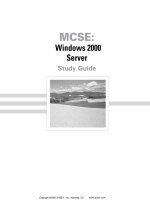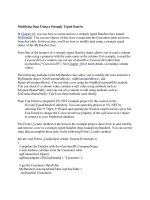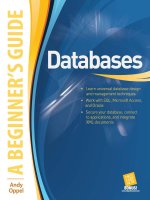Tài liệu Medical Data Management A Practical Guide docx
Bạn đang xem bản rút gọn của tài liệu. Xem và tải ngay bản đầy đủ của tài liệu tại đây (1.15 MB, 218 trang )
Health Informatics
(formerly Computers in Health Care)
Kathryn J. Hannah Marion J. Ball
Series Editors
Springer
New York
Berlin
Heidelberg
Barcelona
Hong Kong
London
Milan
Paris
Singapore
Tokyo
This page intentionally left blank
Florian Leiner Wilhelm Gaus
Reinhold Haux Petra Knaup-Gregori
Authors
Medical Data Management
A Practical Guide
Foreword by Dr. Gustav Wagner
Florian Leiner, PhD Wilhelm Gaus, PhD
(Adjunct Lecturer at the University for Department of Biometry and
Health Informatics and Technology Medical Documentation
Tyrol, Innsbruck, Austria) University of Ulm
Stuckstrasse 4 Schwabstrasse 13
D-81677 Munich, Germany D-89075 Ulm, Germany
Reinhold Haux, PhD Petra Knaup-Gregori, PhD
Institute for Health Information Systems Institute of Medical Biometry and
University for Health Informatics and Informatics
Technology Tyrol University of Heidelberg
Innrain 98 Im Neuenheimer Feld 400
A-6020 Innsbruck, Austria D-69120 Heidelberg, Germany
Series Editors:
Kathryn J. Hannah, PhD, RN Marion J. Ball, Ed.D.
Adjunct Professor, Department Vice President, Clinical Solutions
of Community Health Science Healthlink
Faculty of Medicine 2 Hamill Road
The University of Calgary Quadrangle 359 West
Calgary, Alberta, Canada
and
Adjunct Professor
The Johns Hopkins University
School of Nursing
Baltimore, MD, USA
Cover art © 2002 by Roy Wiemann.
With 7 figures.
Library of Congress Cataloging-in-Publication Data
Medizinische Dokumentation. English.
Medical data management / editors, Florian Leiner . . . [et al.].
p. ; cm. — (Health informatics)
A Practical Guide.
Includes bibliographical references and index.
ISBN 0-387-95159-8 (softcover) ISBN 0-387-95594-1 (hardcover) (alk. paper)
1. Medical records—Data processing. 2. Database management. 3. Medicine—Data
processing. 4. Information storage and retrieval systems. I. Leiner, F. (Florian) I. Title.
III. Series.
[DNLM: 1. Medical Records. 2. Forms and Records Control—methods. 3. Information
Storage and Retrieval. 4. Information Systems. WX 173 M4879 2002a]
R864.M476 2002
651.5´04261—dc21 2002070549
ISBN 0-387-95159-8 (softcover) ISBN 0-387-95594-1 (hardcover) Printed on acid-free paper.
Authorized translation of the third German language edition Leiner F, Gaus W, Haux R.
Medizinische Dokumentation
© 1999 by F.K. Schattauer Verlag GmbH, Stuttgart - New York.
© 2003 Springer-Verlag New York, Inc.
All rights reserved. This work may not be translated or copied in whole or in part without the written permission of the
publisher (Springer-Verlag New York, Inc., 175 Fifth Avenue, New York, NY 10010, USA), except for brief excerpts in
connection with reviews or scholarly analysis. Use in connection with any form of information storage and retrieval,
electronic adaptation, computer software, or by similar or dissimilar methodology now known or hereafter developed is
forbidden.
The use in this publication of trade names, trademarks, service marks, and similar terms, even if they are not identified
as such, is not to be taken as an expression of opinion as to whether they are subject to proprietary rights.
While the advice and information in this book are believed to be true and accurate at the date of going to press, neither
the authors nor the editors nor the publisher can accept any legal responsibility for any errors or omissions that may be
made. The publisher makes no warranty, express or implied, with respect to the material contained herein.
Printed in the United States of America.
987654321 SPIN 10785042 (softcover) SPIN 10894053 (hardcover)
Typesetting: Pages created by the authors using MS Word 97.
www.springer-ny.com
Springer-Verlag New York Berlin Heidelberg
A member of BertelsmannSpringer Science+Business Media GmbH
To
Professor Herbert Immich
This page intentionally left blank
__________________________________________________ Foreword ______________ vii
Foreword to the First German Edition
Modern medicine is characterized by the continuously growing
spectrum of improving diagnostic methods and therapeutic proc-
esses. It keeps getting more complicated and confusing and there-
fore also needs more order.
The main goal of medical documentation is to provide information
for the adequate care of patients. Carefully carried out written
records like a patient history, physician indexes, or, more recently,
patient databases serve to reach this goal.
Moreover, progress in clinical medicine is based on the exchange
of experiences that are themselves largely based on the uniform
entry, use, and analysis of comparable data and findings obtained
from unhealthy participants. National and international institutions
have been trying for years to come up with premises for this. The
so-called “Blue Books” of the World Health Organization (WHO)
for the standardization of the histological classification of tumors,
the International Classification of Diseases for Oncology (ICD-O)
for the standardized recording of tumor localization and morphol-
ogy, and the TNM-System and TNM-Atlas of the International
Union Against Cancer (UICC) for the documentation of studies of
tumors are cited, for example, in the clinical oncology sector. The
existence of classification systems has cleared the way for the
modern, internationally accepted documentation of medically in-
teresting matters.
The increased specifications in health structure law regarding the
creation of physician reports as well as lawmakers’ and the medi-
cal associations’ increased efforts to improve quality assurance in
medicine require the detailed documentation of patient-based data
and findings. The fact that carefully designed medical documents
are of value for physicians (e.g., for legal disputes) as well as for
patients in critical situations where the documentation could be
lifesaving is only briefly mentioned.
The fascination of the possibilities in medicine that have been
made available through computers unfortunately relegated knowl-
edge about the importance of careful documentation to the back-
ground in past years.
In 1975, the field was described in the Handbook of Medical
Documentation and Data Processing. Today, 20 years later, there
are many books that cover an aspect of the field. But a book about
the core theme of medical informatics has not been written. It is
therefore even more welcome that the authors of this textbook
handle the theme in detail in consideration of new technological
viii Foreword
advances. They also prove the relevance of medical documentation
as needed for optimal patient care and clinical research.
A requirement gap that has been around for a long time has finally
been closed with this introduction on hand. Interested physicians
and students of medicine, medical informatics, and informatics,
such as medical documentors and documenting assistants, will
greet the arrival of this textbook and find it useful.
Prof. Dr. Gustav Wagner
Heidelberg, Germany
June 1995
______________________________________________ Series Preface _______________ix
Series Preface
This series is directed to health care professionals who are leading
the transformation of health care by using information and knowl-
edge. Launched in 1988 as Computers in Health Care, the series
offers a broad range of titles: some addressed to specific profes-
sions such as nursing, medicine, and health administration; others
to special areas of practice such as trauma and radiology. Still
other books in the series focus on interdisciplinary issues, such as
the computer-based patient record, electronic health records, and
networked health care systems.
Renamed Health Informatics in 1998 to reflect the rapid evolution
in the discipline now known as health informatics, the series will
continue to add titles that contribute to the evolution of the field.
In the series, eminent experts, serving as editors or authors, offer
their accounts of innovations in health informatics. Increasingly,
these accounts go beyond hardware and software to address the
role of information in influencing the transformation of health care
delivery systems around the world. The series also will increas-
ingly focus on “peopleware” and organizational, behavioral, and
societal changes that accompany the diffusion of information tech-
nology in health services environments.
These changes will shape health services in the next millennium.
By making full and creative use of the technology to tame data and
to transform information, health informatics will foster the devel-
opment of the knowledge age in health care. As coeditors, we
pledge to support our professional colleagues and the series read-
ers as they share advances in the emerging and exciting field of
health informatics.
Kathryn J. Hannah
Marion J. Ball
This page intentionally left blank
____________________________________________________ Preface _______________xi
Preface
Careful documentation is essential in all fields of medicine and
health care, whether it may serve the treatment of patients, compli-
ance with legal obligations, reimbursement and cost analysis,
quality assurance, or clinical research. Clinical documentation
must be conducted in a systematic way; otherwise, there is a dan-
ger of it becoming a tiresome affair, consuming an excessive
amount of time and money, and being of hardly any use.
This book describes the basic concepts of clinical documentation
and data management. We have tried to keep it as simple as possi-
ble—but not simpler.
The book is intended to assist you in designing and using clinical
documentation and data management systems. We present the
most relevant clinical coding systems (e.g., for coding diagnoses)
and typical clinical documentation (e.g., the patient record). Hos-
pital information systems and clinical studies are very important
application areas of clinical documentation; we give an overview
of both. Our thesaurus makes up a good part of the book. Use it to
look up definitions and relations of the concepts treated in the
book. All concepts defined in the thesaurus are set in boldface the
first time they appear in a chapter.
The book is geared toward students who are trained in clinical
documentation and data management, for example in the areas of
medicine and medical/health informatics, as well as health infor-
mation managers. As an introduction, it is also suitable for physi-
cians, nurses, and other health care professionals who design or
use clinical data management systems.
The authors offer the information contained in this book in the
form of lectures mainly for students of medical/health informatics
and health information management, but also for medical students
and physicians. Depending on thoroughness and the background of
the audience, the complete material can be taught in about 12 to 24
hours of instruction. The audience should command the most basic
medical knowledge, particularly some medical terminology.
We recommend that instructors accompany the lectures with prac-
tical exercises of the use of clinical data management systems and
clinical coding systems. Provide your students with real coding
systems and—to cite just two examples—have them code diagno-
ses with the ICD and stage cases with the TNM system.
Subject, goals,
and contents of
the book
Who should
read this book?
How to impart
information?
xii Preface
The first German edition of this book appeared in 1995. This Eng-
lish edition corresponds to the Third German edition of 1999.
In preparing this book, many persons supported us in various
ways. We express our gratitude to all of them, even if we can name
only a few here.
Invaluable advice came from our colleagues of the German Society
of Medical Informatics, Biometry, and Epidemiology, particularly
from the Working Group on Medical Documentation and Classifi-
cation. Special thanks go to Birgit Brigl, Karl-Heinz Ellsässer,
Ewald Glück, Stefan Gräber, Bernd Graubner, Rüdiger Klar, Tibor
Kesztyüs, and Martin Schurer.
To translate a book into a foreign language and publish it with an
international scope is an ambitious project. We would not have
succeeded without the help and support of Anita Lagemann, Mar-
ion Ball, Frieda Kaiser, Merida Johns, and Jeremy Wyatt.
The authors have been greatly influenced by Herbert Immich, for-
mer director of the Institute of Medical Documentation, Statistics
and Data Processing at the University of Heidelberg. We dedicate
this book to him.
Not least, we want to thank our students who kept asking critical
questions and drew our attention to incomplete and indistinct ar-
guments.
Florian Leiner Wilhelm Gaus
Munich, Germany Ulm, Germany
Reinhold Haux Petra Knaup-Gregori
Innsbruck, Austria Heidelberg, Germany
March 2002
Corresponding
German edition
Acknowledg-
ments
___________________________________________________ Contents______________ xiii
Contents
Foreword to the First German Edition vii
Series Preface ix
Preface xi
1 What Is Medical Documentation About? 1
1.1 What It Is and What It Isn’t 1
1.2 Medical Documentation: Do We Really Need It? 2
1.2.1 Problems and Motivation 2
1.2.2 More Important Today Than Ever Before 3
1.3 What Are the Objectives of Medical Documentation? 3
1.3.1 General Objectives 3
1.3.2 Objectives in Patient Care 4
1.3.3 Objectives in Administration 4
1.3.4 Objectives in Quality Management and Education 5
1.3.5 Objectives in Clinical Research 5
1.4 Multiple Use of Patient Data 6
1.5 Medical Documentation: Child’s Play? 7
1.6 Computer-Supported Medical Documentation: A Panacea? 8
1.7 Checklist: Objectives of Medical Documentation 8
1.8 Exercises 9
2 Basic Concepts of Clinical Data Management and Coding Systems 11
2.1 The Documenting Institution 11
2.1.1 The Physician’s Office and the Outpatient Clinic 11
2.1.2 The Hospital 12
2.1.3 Other Relevant Institutions 13
2.2 From Attributes to Data Management 15
2.2.1 Objects and Attributes 15
2.2.2 Definitions, Labels, and Terminology 17
2.2.3 Data, Information, and Knowledge 19
2.2.4 Documents 21
2.2.5 Data Management Systems 21
2.2.6 Exercises 22
xiv Contents
2.3 Clinical Data Management Systems 23
2.3.1 Characteristics of Clinical Data Management Systems 23
2.3.2 Exercises 30
2.4 Medical Coding Systems 30
2.4.1 Coding Systems: Why Do We Need Them? 31
2.4.2 What Is a Coding System? 32
2.4.3 Classifications and Nomenclatures 32
2.4.4 A Few Additional Remarks 41
2.4.5 Exercises 41
3 Important Medical Coding Systems 43
3.1 International Classification of Diseases (ICD) 43
3.1.1 The 10th Revision (ICD-10) 44
3.1.2 Extensions to the ICD 46
3.2 Procedure Classifications 47
3.2.1 International Classification of Procedures in Medicine (ICPM) 47
3.2.2 ICD-10-Procedure Coding System (ICD-10-PCS) 49
3.3 Systematized Nomenclature of Medicine (SNOMED) 52
3.3.1 SNOMED Reference Terminology (SNOMED RT) 53
3.3.2 SNOMED Clinical Terminology (SNOMED CT) 56
3.4 The TNM Classification of Malignant Tumors 57
3.4.1 Structure 58
3.5 MeSH and UMLS 60
3.6 Exercises 60
4 Typical Medical Documentation 63
4.1 The Patient Record 63
4.2 Patient Record Archives 65
4.3 Clinical Basic Data Set Documentation 66
4.4 Clinical Findings Documentation 67
4.5 Clinical Tumor Documentation 68
4.6 Documentation for Quality Management 69
4.7 Clinical and Epidemiological Registers 71
4.8 Documentation in Clinical Studies 72
4.9 Documentation in Hospital Information Systems 73
4.10 Exercises 73
___________________________________________________ Contents______________ xv
5 Utilization of Clinical Data Management Systems 75
5.1 Patient-Oriented Analysis 75
5.2 Patient-Group Reporting 78
5.3 Clinical Studies 82
5.4 Quality Measures in Information Retrieval 86
5.5 Exercises 87
6 Clinical Data Management: Let’s Make a Plan! 89
6.1 Planning Medical Coding Systems 89
6.1.1 General Principles 89
6.1.2 Principles of Ordering Qualitative Data 90
6.1.3 Principles of Ordering Quantitative Data 91
6.2 Planning Clinical Data Management Systems 92
6.2.1 Why Plan Them at All? 92
6.2.2 The Documentation Protocol 93
6.2.3 Prolective and Prospective Analyses 94
6.2.4 Additional Remarks 94
6.3 Example: A Tumor Documentation Protocol 95
6.4 Exercises 102
7 Documentation in Hospital Information Systems 103
7.1 The Hospital Information System 103
7.1.1 The Concept 103
7.1.2 The Significance 104
7.1.3 The Need for a Strategic Plan 105
7.1.4 Important Hospital Functions 107
7.1.5 Exercises 110
7.2 Management and Operation of Hospital Information Systems 110
7.2.1 The Strategic Plan 112
7.3 The Electronic Patient Record 112
7.3.1 What Is an Electronic Patient Record? 113
7.3.2 Advantages and Disadvantages of the Electronic Patient Record 114
7.3.3 Introducing the Electronic Patient Record 115
7.4 Methodology of Medical Documentation 116
8 Data Management in Clinical Studies 117
8.1 Therapeutic Trials 118
xvi Contents
8.2 Good Clinical Practice (GCP) 119
8.3 Study Protocol 120
8.4 Case Report Forms (CRFs) 120
8.5 Monitoring 121
8.6 Auditing and Quality Assurance 122
8.7 Processing of the Primary Data 123
8.7.1 Checking and Correcting Data 123
8.7.2 Classification of Nonstandardized Entries 123
8.7.3 Secondary Data Acquisition 124
8.7.4 Database Closure 124
8.8 Analysis 125
8.9 Archiving the Trial Master File 125
8.10 Checklist: Data Management in Clinical Studies 126
8.11 Exercise 127
9 Concluding Remarks 129
10 Suggested Further Information 131
10.1 General References 131
10.2 Standardization Bodies 131
10.3 Education in Medical Documentation 132
10.4 Professional and Other Relevant Organizations 133
10.5 Information on Coding Systems 133
10.6 Basic Literature on Medical Documentation 134
11 Thesaurus of Medical Documentation 137
11.1 Documentation Protocol of the Thesaurus 137
11.2 Thesaurus Entries 139
12 Index 197
__________________________ What Is Medical Documentation About? _______________1
What Is Medical Documentation About?
Documentation denotes the methods and activities of collecting,
coding, ordering, storing, and retrieving information to fulfill
specific future tasks.
Information is often contained in documents. To retrieve docu-
ments containing a specific piece of information, they previously
must have been coded correctly.
This definition clarifies it: Documentation is no end in itself. In-
formation is only documented in order to use it later on—without
this, collecting, labeling, ordering, and storing would be useless.
Thus, documentation is meant to put information at the disposal of
authorized persons in a purposeful manner. To be precise: it must
be presented completely, without noise, at the right time, at the
right place, and in the right form. Therefore, documentation can be
said to serve information and knowledge logistics.
In this chapter you will learn
- the central significance of medical documentation for medi-
cine, i.e., for patient care as well as for medical research;
- that medical documentation does not have to be taken as an
unavoidable fate but that it is most important to set goals and to
proceed systematically to achieve them with the least amount of
effort;
- what objectives and results a documentation can attain;
- why methods for documentation have to be chosen carefully for
the specific objectives; why these methods have to be applied
with proficiency; and why good documentation is always a
matter of both diligence and creativity;
- the potential of computer-based data management systems,
and why the computer doesn’t automatically make documen-
tation better.
What It Is and What It Isn’t
Medical documentation can deal with very different kinds of in-
formation. These reflect the different objectives and tasks of
documentation that, on the other hand, require the use of different
documentation methods.
Since we cannot completely cover the wide variety of objectives
and methods, the main focus of this book is on the documentation
of statements related to the illness and medical care of individual
patients. This kind of documentation, which we term clinical
1
Introduction
What will you
learn?
1.1
Focus on
clinical
documentation
2 What Is Medical Documentation About?
documentation, typically contains information about the history,
the symptoms, clinical findings, diagnoses, therapies, and progno-
sis of a patient’s illness.
This does not mean that we will ignore, for example, caregiving
documentation, the documentation of medical textbook knowl-
edge, or epidemiological databases completely. But we will deal
with them only where they relate to our main focus.
In Germany, medical documentation stands for a concept that
includes the contributions of all health care professions. So, in our
definition and usage, nursing documentation is a specification, or
sort, of medical documentation.
Medical Documentation: Do We Really Need It?
Medical documentation within the context of patient care some-
times seems to be just tedious form-filling or drudgery at the com-
puter. Who really needs documentation? Does it serve only bu-
reaucracy? Who takes advantage of it? Questions like these are
discussed in the following section.
Problems and Motivation
A lot of documentation takes place in our hospitals and doctors’
practices. A university hospital, for example, produces roughly 6
million documents (discharge summaries, laboratory results, etc.)
per year. Storing these documents conventionally on paper would
mean that about 1.5 kilometers of filing space are needed for pa-
tient records. What makes all this effort worthwhile?
First, appropriate recording of data is necessary for the accurate,
continuous treatment of a patient. Records contain statements
about the course of the treatment made by another person at an
earlier place and time.
Certain data have to be acquired according to legal and other
regulations. When going to court, it is important not only that a
required action had been taken but also that it was documented.
Certainly, documentation is also done for administrative purposes:
After all, it is important that expenses stay within reasonable
bounds and that health care interventions are adequately reim-
bursed.
Measures taken to ensure the quality of patient care are, to a
considerable extent, based on the documentation of treatment data.
The same applies to clinical research activities, which play an
important role, at least at university hospitals.
What about
nursing docu-
mentation?
1.2
sinceit’sso
boring
1.2.1
Is it
worthwhile?
__________________________ What Is Medical Documentation About? _______________3
More Important Today Than Ever Before
Hippocrates recommended the acquisition of patient data to his
students. However, there has been a growing impression in recent
decades that traditional documentation methods are no longer suf-
ficient. What led to this impression?
First of all, today’s diagnostics are much more complex than ever
before. Many diagnostic actions result in an immense amount of
quantitative and qualitative findings that need to be assessed to-
gether.
Nowadays, extreme division of labor in patient care is common.
This leads to a high demand for communication between all
health professionals, laboratories, etc. Moreover, there is greater
regional mobility among patients, and they are more prepared to
change doctors from time to time.
Due to the successes of modern medicine, especially concerning
acute diseases, the chronic diseases and multimorbidity at ad-
vanced ages play a more important role today. Therefore, clinical
manifestations are getting more and more complex.
New documentation tasks, mainly for legal and financial purposes,
have been added to the traditional ones. The use of computers
enables extensive documentation and many diverse analyses. This
fosters the wish to use the stored data on a large scale, e.g., for
scientific research.
What Are the Objectives of
Medical Documentation?
The motivation for medical documentation can be expressed in
general terms, i.e., in an abstract way, as well as with reference to
the concrete contents that should be documented. We will specify
this in the following sections, restricting ourselves to clinical
documentation (see above).
General Objectives
In the introduction of this chapter we already the general, abstract
objective of medical documentation: to provide authorized persons
with all relevant information (but not more) about one or several
patients and their treatment, at the right time, at the right place,
andintherightform.
Virtually every word of this phrase points to a whole range of re-
quirements. “Authorized persons” requires taking complex access
control structures into consideration; “all relevant information”
1.2.2
An old
concept
with growing
importance
1.3
Introduction
1.3.1
Information
logistics
is demanding
4 What Is Medical Documentation About?
requires mechanisms for ensuring the completeness of data and
for the filtering of unnecessary detail or noise; “at the right time”
puts great demands on the technical and organizational aspects of a
system; “at the right place” is aimed at flexible and powerful con-
cepts and tools for the transport of information; “in the right form”
implies elaborate methods for processing and presenting informa-
tion.
Based on this very general wording you cannot tell what the ob-
jectives of a concrete data management system are. Who are the
authorized persons? What is the relevant information, and what
should it be relevant for, anyway? We will deal with these ques-
tions in the next section. We would like to consider these general
objectives as a sort of guideline for the formulation of complete
and useful objectives of a data management system.
Objectives in Patient Care
In the end, the most important objective of medical documentation
is to contribute to effective and appropriate medical care for each
individual patient. For each patient, the data management system
has to provide all data that are relevant to decisions about diag-
nostic, therapeutic, or nursing interventions (i.e., health care inter-
ventions).
As a reminder, documentation helps to remember observations and
health care interventions—be they finished, in progress, or still at
a planning stage. As a communication aid, documentation supports
the exchange of information between health care professionals. A
patient record, for instance, fulfills both of these functions by
bridging the time between two stays in a hospital, and by bridging
the change of health professionals caring for the patient during
these stays. Instead of exchanging patient records, communication
between health care institutions usually occurs in the form of
summary reports (e.g., discharge summaries, result reports, etc.).
There is another medical documentation task with a more limited
scope in time and place: it supports the organization of health care
interventions, for example, by recording test orders, treatment
plans, and readmission dates.
Objectives in Administration
In the administrative sector, medical documentation can support a
health care institution (for example, a hospital) in getting appro-
priate reimbursement for its services and in selecting and design-
ing efficient work processes.
1.3.2
Makes patient
care more
effective and
appropriate
1.3.3
Forms the basis
for refunding,
process
planning,
and control
__________________________ What Is Medical Documentation About? _______________5
Since reimbursement depends to a great degree on the amount of
services, there is a significant need for timely, reliable, and com-
plete information about the performed interventions. The board of
directors of a health care institution also has to plan and control
the institution’s work processes. Here, medical documentation
helps to increase transparency by allocating the institution’s costs
to the providers and the receivers of services.
A number of implications arise for the appropriate documentation
of patient care with regard to legislation and jurisdiction. In the
event of legal proceedings, an inadequate amount of documenta-
tion can have negative implications for the health care institution.
Liability claims can be expected when documentation systems
aren’t used correctly, or aren’t used at all.
Depending on a country’s regulations for reimbursement or ac-
creditation, there are a number of obligations for an institution’s
documentation procedure.
Objectives in Quality Management and Education
There is an ethical—and, in many countries, a legal—obligation
for health care providers to ensure a high quality of patient care.
The goal of medical documentation is to support the quality man-
agement of a health care institution, especially by providing ap-
propriate information:
- in retrospect for the critical reflection on individual courses of
illness (medical audit), and
- for systematic quality monitoring (where certain attributes of
selected types of health care interventions are continually
checked).
Medical documentation can be a valuable tool for the education
and training of health care professionals. There are two primary
functions:
- to provide a record for the critical evaluation of a student’s
actions and assessments, and
- to provide exemplary and realistic clinical problems and de-
scriptions of courses of illness.
Objectives in Clinical Research
The objective of clinical research is to generalize the experiences
drawn from the care of individual patients, and to describe the
rules that can be derived from those generalizations. Medical
documentation can contribute to this objective as follows:
1.3.4
Supports criti-
cal reflection
and systematic
monitoring
1.3.5
Allows patient
selection and
statistical
analysis
6 What Is Medical Documentation About?
- by providing appropriate information for the critical evaluation
of individual courses of illness in order to detect starting points
for generalizations;
- by enabling the selection of patients with specific characteris-
tics (e.g., all male patients with anterior myocardial infarction).
This selection then forms the basis for a scientific study that
has to be planned and documented separately;
- by providing particular data about a well-defined set of patients
that enter into a planned evaluation study (for example, ana-
lyzing the frequency of stomach trouble after taking a pain-
killer).
Multiple Use of Patient Data
Quite often, the same patient data are acquired several times for
different objectives at different locations (not only patient data, but
this is our main focus). In fact, the staff and patient expenses that
arise from this cannot be justified. Computer-based data manage-
ment systems offer the possibility of the multiple use of data
recorded once to be used for different objectives and tasks.
A surgeon encodes, for example, a patient’s diagnosis and therapy
for the operation report. After the patient’s discharge, this report
forms the basis of the discharge report. The discharge report is the
most important document for communication with the outpatient
clinic or the practitioner taking over the care of the patient. Data
on diagnosis and therapy are also important elements of problem
lists, progress notes, nursing records, etc. They are necessary items
for studies in quality management. In many countries, reimburse-
ment depends in some way on diagnoses and therapies. Finally, the
efficient management of a health care institution requires the
treatment costs (e.g., consumption of material and drugs) to be
contrasted with the kind and severity of the patient’s illness, char-
acterized by diagnosis and therapy.
Fig. 1.1 is a diagram of the basic problem regarding the multiple
use of data: Depending on the question you pose and your view-
point, your information need will be different. For the treatment of
a patient, you will need a complete and concise overview of all
data that are relevant for the decisions in that particular case; for a
scientific study, comparability and reliability are of primary inter-
est, which means that there will be a well-defined selection of
(possibly very few) attributes of all patients of the study sample.
The multiple use of patient data can actually only be ensured when
the following conditions are met:
1.4
Capture it once,
use it
extensively
Problems
It has to be
planned
__________________________ What Is Medical Documentation About? _______________7
patient-group
analysis
patient-oriented
analysis
data objects
of patient A
data objects
of patient B
data objects
of patient C
- All tasks of the data management system and all questions for
analysis have been arranged beforehand.
- The demands on the quality of the data depend on the most
ambitious task. (For example, the result of a physical examina-
tion may be formulated in free terms for the purpose of individ-
ual patient care. For a clinical study, on the other hand, some
attributes have to be captured completely and follow clear
guidelines, whereas other attributes do not have to be taken into
account at all.)
Fig. 1.1 Diagram of the multiple use of patient data: patient-oriented versus patient-group
analyses as an example to demonstrate different information needs for different
objectives of documentation.
When patient data within a certain field shall be used in multiple
ways, documentation has to be planned and coordinated between
all persons involved in order to fulfill the above-mentioned condi-
tions.
The use of data for a task that has not been taken into account
during the planning of the data management system can pose great
problems. Technically it can be facilitated by standardized
documentation, but this will not guarantee the data’s semantical
suitability for the new task.
Medical Documentation: Child’s Play?
The most annoying part of documentation is that it often seems to
take an unreasonable amount of time. This is particularly true
when documentation is carried out unskillfully—not to say ama-
teurishly. Selecting incorrect documentation methods (or using
correct methods in the wrong way) produces a lot of unnecessary
work, and often even leads to incorrect conclusions being drawn
from the documentation.
1.5
Do it right
—or leave it
8 What Is Medical Documentation About?
Unnecessary expenses often arise when the same data are acquired
repeatedly for different tasks instead of using the information in
multiple ways (see section 1.4).
On the other hand, each analysis goal makes certain demands on
the documentation’s quality, e.g., with respect to its completeness
of attributes and of data objects, its accuracy in every detail, and
its conformity. Analyzing data without having selected appropriate
documentation methods right from the start entails the risk of sub-
stantial misinterpretations. The research funds spent in that way
could have been used elsewhere much more efficiently!
Computer-Supported Medical Documentation:
A Panacea?
It is well known that computers aid in documentation. But this is
only true when, in the course of introducing computer support, the
documentation’s structure has been reviewed critically. Otherwise,
it is to be expected that bad documentation will be faithfully trans-
formed into bad computer-based documentation. From a technical
point of view, a computer tremendously extends the possibilities of
storing and analyzing data. This fact creates the temptation to rec-
ord “everything” in the vain hope of possessing the answers to all
possible questions. There are three points we want to make about
computer-based medical documentation:
- The basic methodology for documentation is to a great extent
independent of the storage medium.
- The use of computers requires additional methods, for example
for the construction of computer-based application systems,
for database design, or for computer-based communication.
- The use of computers can have great advantages over conven-
tional documentation (e.g., the simultaneous availability of data
at different places, fast and secure data processing, a decrease
in work load) but can have disadvantages as well (e.g., more
awkward use or higher expenses). Through the use of a com-
puter, documentation often gets more abstracted and quite often
inscrutable, so that incorrect data or mistakes in operating the
program go unnoticed in many cases (black-box effect).
Checklist: Objectives of Medical Documentation
The general objective of information and knowledge logistics in
medicine is:
To make available the right medical information (e.g., about a
patient) and the right medical knowledge (e.g., about a disease) at
1.6
Computers
support good
and bad
concepts
1.7
Checklist









